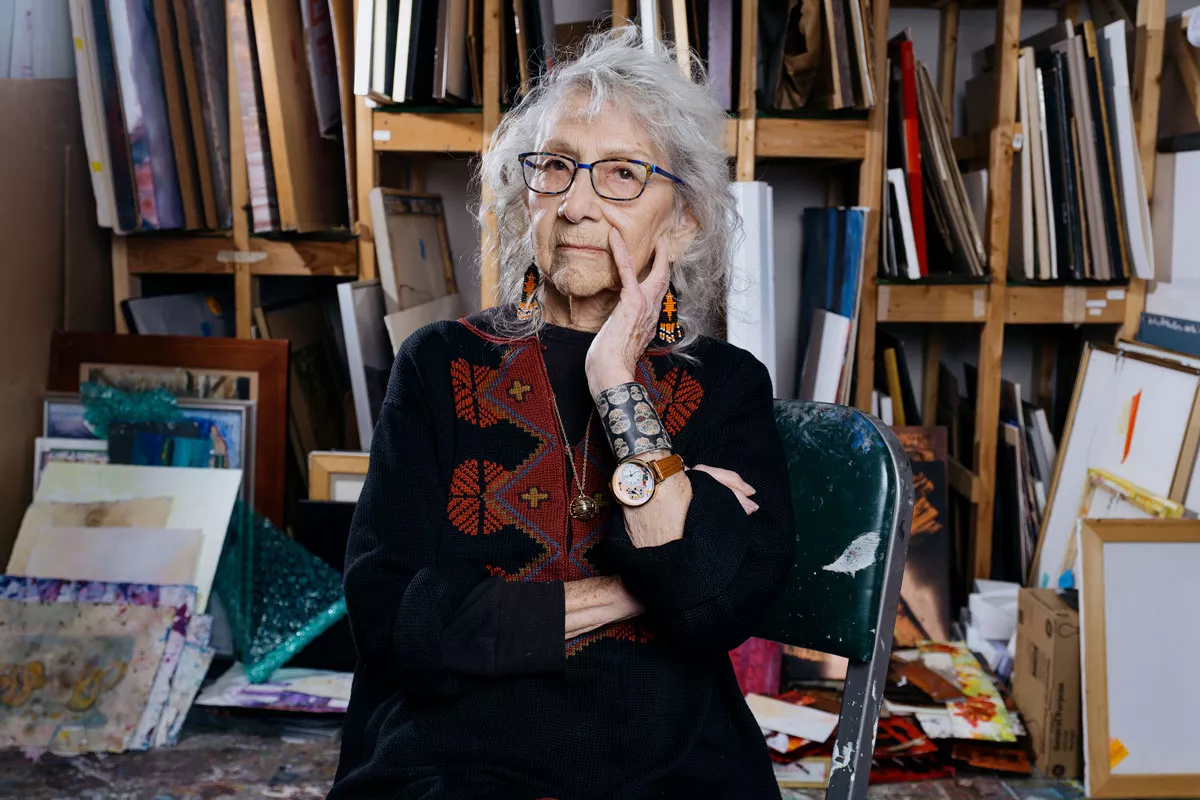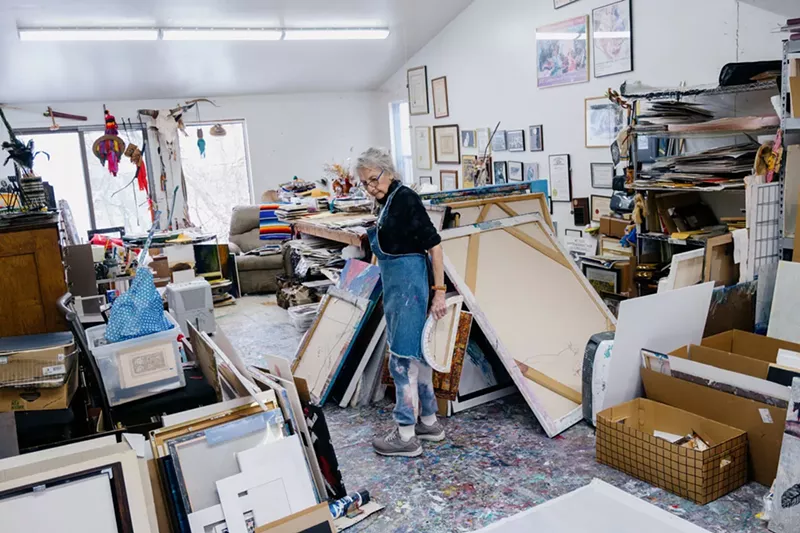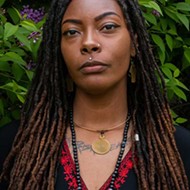Nora Chapa Mendoza is the 2024 Kresge Eminent Artist — and it’s well deserved
She’s championed the rights of women, migrant workers, and Native Americans for 50+ years


Audio By Carbonatix
[
{
"name": "GPT - Leaderboard - Inline - Content",
"component": "35519556",
"insertPoint": "5th",
"startingPoint": "3",
"requiredCountToDisplay": "3",
"maxInsertions": 100,
"adList": [
{
"adPreset": "LeaderboardInline"
}
]
}
]
Even in her nineties, Detroit artist Nora Chapa Mendoza is making history.
Chapa Mendoza became the first Chicana artist to sign the Scarab Club beams last year, joining the likes of Diego Rivera, Isamu Noguchi, and Margaret Bourke-White in the gallery’s coveted “guest book.” Now, at 92 years old, she’s been named the Kresge Eminent Artist of 2024 — and is reportedly the first Hispanic artist to receive the distinguished award.
The trailblazing artist, gallerist, and activist’s career spans five decades of championing the rights of women and migrant workers while celebrating her Hispanic and Native American heritage.
“For a very long time, we have not been asked or invited to participate or exhibit at this level. I’m glad that it happened eventually,” Chapa Mendoza tells Metro Times over the phone about receiving the honors. “It’s important for me to speak for those of us who have been left behind.”
Mendoza says her work takes whatever form calls to her, whether it’s an oil painting, assemblage, paper-mâché relief, or mixed media piece. Whatever the medium, Chapa Mendoza’s pieces often lean toward the abstract, anchored by symbols of her Indigenous spirituality and Chicana heritage.
“I walk into my studio and they’re all sort of like, ‘Me, me, me!’” she says about her different mediums, laughing. “Sometimes I go into my studio just to bring something out and hours later I realize I haven’t gone back into the house. I put the canvas on the floor, I start splashing things around, and before long I know exactly where I’m going.”
Chapa Mendoza studied at the College for Creative Studies (CCS) back when it was called the Center for Creative Studies, as well as Madonna University. She also studied with local painters Richard Kozlow and Ljubo Biro, who became her mentors. She was a founding member of Nuestras Artes de Michigan, a collective of Latin artists with chapters in Detroit, Pontiac, and Ann Arbor. And she opened Detroit’s first solely Latin American-focused gallery, Galeria Mendoza, in Harmonie Park in 1981. She ran Galeria Mendoza for three years until closing it to focus on her own work.

While Mendoza wasn’t born in Detroit, it was here that she blossomed into a working artist. She was born in Weslaco, Texas, miles away from the U.S.-Mexico border, to a life of poverty.
Her mother died when Chapa Mendoza was only four years old, leaving her father, a 25-year-old house painter, alone to raise three children. While her father sought more work elsewhere, she was raised by her grandmother and aunt who picked citrus fruits and cotton around Weslaco. Often, a young Chapa Mendoza helped them.
Growing up with family members who worked the land inspired Chapa Mendoza to not only paint migrant workers but also to speak out against their unfair working conditions and treatment.
In the late 1980s, she met labor leader Cesar Chavez, who co-founded what’s known today as the United Farm Workers Union, and showed him pieces she had painted of migrant workers. He then commissioned her to create a series of paintings and postcards to benefit the union efforts called “Children of the Fields.”
“I really don’t consider myself an activist, I just do what I do naturally,” she says. “You speak for the people because that’s what you feel. [I wanted] to make people aware of who we are, what we do, and why we do it.”
Even though her father was painting houses instead of canvases, she credits him with encouraging her to pick up a paintbrush and teaching her basic techniques when they were eventually reunited.
“I used to play with sand and was always creating pictures with the dirt or anything handy,” she remembers. “My father kept cans of paint all over the house so he would take me outside and show me how to match colors [and] how to paint a trim on a window without touching the glass.”
She moved to Detroit in 1953 with her then-husband when she was 21 years old. Her husband, who was a doctor, did not want her to pursue a career as an artist and instead told her to focus on being a mother. Thankfully, Chapa Mendoza divorced him and decided to follow her dreams. This is the moment of her metamorphosis and dedication to herself as an artist.
“For a long time when I was married, I treated my work as a hobby because my husband didn’t want me to earn any money,” she says. “I was already doing workshops and classes, but not as a professional.”
Her daughter Laurie Psarianos says her mother’s painting “Metamorphosis” depicts her transition from a doctor’s wife to a full-time artist. It shows a young woman’s face as it emerges from an older version of herself and a skull.
“She just turned 92 on Saturday and she continues to go out into [her studio] and paint every day,” Psarianos says.
Her mother quips, “It’s not like I choose to paint. The paint chooses me. For me, painting is like eating. Just as I need to eat to live, I need painting to nurture my soul, my heart, [and] my inner being. If I stopped painting, what would be the point in living?”
In a statement from Kresge, Scarab Club gallery director Dalia Reyes likens Mendoza to Frida Kahlo, calling her work “a captivating visual diary, offering profound insights into the rich tapestry of experiences that define her life.”
Chapa Mendoza also had a solo show at the Scarab Club, Stages of a Life: A Retrospective, in 2023 when she signed the beams.
The Kresge Eminent Artist honor comes with a cash award of $100,000, which was increased this year from $50,000. Kresge has also increased the awards for Kresge Artist Fellows, a smaller award recognizing artistic excellence, from $25,000 to $40,000 this year.
Chapa Mendoza joins 15 previous Kresge Eminent Artist: visual artists Charles McGee, Ruth Adler Schnee, Marie Woo, Shirley Woodson, and Olaymi Dabls; musicians Marcus Belgrave, Patricia Terry-Ross and Wendell Harrison; writers Bill Harris, Naomi Long Madgett, Gloria House, and Melba Joyce Boyd; photographers Bill Rauhauser and Leni Sinclair; and composer-impresario David DiChiera.
Later this year, a short film and book about Mendoza’s career will be released as part of the award.
Subscribe to Metro Times newsletters.
Follow us: Google News | NewsBreak | Reddit | Instagram | Facebook | Twitter






